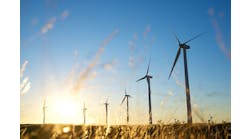This article is part of a series on industrial sustainability. Read more here.
Just as improving the efficiency of motors and other equipment can pave the way to sustainability, common process control instruments can help accomplish the same goal, especially if they're aided by software, Ethernet, Internet, cloud/edge computing and other digitalized functions.
For instance, the U.K.-based HyDeploy Project is demonstrating safe distribution and use of hydrogen blends in a live gas network in England's midlands, but it needs to ensure on-spec blending into the network with accurate compositional data of the full hydrogen/natural gas (H2/NG) blend, and reliably track and validate its blend rate. The project is operated by a six-partner consortium, including Cadent, Northern Gas Networks, Progressive Energy Ltd., Keele University, HSE-Science Division and ITM Power. The partners manufacture green hydrogen—usually by electrolyzing water with electricity from off-peak wind power—and distribute it to the utility network.
The hydrogen displaces methane in the natural gas, and reduces CO2 when it's burned by commercial and residential consumers. To avoid reduced equipment life and safety concerns, the hydrogen is injected at a maximum rate of 20%, which requires the utility to closely monitor and analyze blend rates and composition of the finished H2/NG product. HyDeploy needed an analyzer such as a gas chromatograph (GC) to speciate and measure the full component range in its gas stream, including the higher concentrations of hydrogen.
Measure to modulate output
To gain the capabilities HyDeploy required, Cadent selected Rosemount 700XA NG gas chromatograph from Emerson that has a high hydrogen measurement limit, field-mountable installation options and an explosion-proof design. It also provides evidence of a stable and consistent blend level throughout the network, and delivers an accurate compositional analysis of the full H2/NG blend, including its quality, calorific value and Wobbe index. While regular air-bath oven GC designs can handle the project's hydrogen range, Emerson reports they require a more elaborate, temperature-controlled shelter. Rosemount 700XA can operate at -20 to 60 °C (-4 to 140 °F), and doesn't need costly instrument air for purging.
Based on Rosemount 700XA's accuracy and reliability, HyDeploy can modulate its output to match local consumption patterns. It can test any specific hydrogen injection rate up to the 20% maximum, and monitor consumer responses. This helps reduce greenhouse gases as the hydrogen blend is distributed throughout the network, minimizing NG consumption.
“The gas chromatograph lets the project track gas quality changes from the initial blend point through the network. It's worked without fault since commissioning, and was a very worthwhile investment and collaboration with Emerson,” says Tommy Isaac, principal engineer at Progressive Energy. "The GC provides an independent validation of the blend rate, allows gas quality data to be captured for combustion experiments being undertaken on the network, and provides evidence of a stable and consistent blend level.”
Selling sustainability
Mark Bulanda, executive president of Emerson's Automation Solutions business, adds that, "In the almost 50 years since the energy crisis of the 1970s, the demise of hydrocarbons has often been forecasted, but its process technologies keep getting better and more efficient. The difference now is we have more automation and a trend toward sustainability that's gaining a lot of public support and generating pressure from investors.
As a result, Emerson recently developed its three-pillared Greening Of, By and With sustainability strategy, which includes what the company is doing to make itself more sustainable in how it uses energy and makes products; how it's helping its customers to do the same; and how it's working with academia, governments and other organizations to develop sustainability policies. "We're also funneling $500 million into decarbonization projects, such as carbon capture, biofuels, hydrogen and others," explains Bulanda. "We have solutions for managing energy and attacking losses, whether it's reducing methane emissions when producing gas, or eliminating compressed air leaks when making cars and other products, but they must prove they can make economic gains, too. There's plenty of talk about sustainability, but when it costs 20% more to make it happen, there's going to be pushback. Consequently, sustainability must show a return on investment (ROI). When it can, it's much easier to sell it and has a much better chance of overcoming barriers to deployment."
Many small steps
To prevent sustainability from being a "boil the ocean" problem that's too overwhelming and never gets addressed, Bulanda emphasizes its supporters need to pursue small, "singles and doubles" successes they can use to build momentum. "And renewable energy can't be the sole source. Hydrocarbons will always have a role in our global energy mix, even if it declines over time," says Bulanda. "I believe the International Energy Association forecast for the upstream and midstream markets is still 5% increases per year for the next five years, and then 1-2% decreases per year for the following 20 years."
Similar to any process application upgrade, migration or other project, Bulanda adds that Emerson helps users with their sustainability efforts by evaluating their individual processes, and learning what they're trying to achieve. "We identify all waste areas, and find ways to help users be more efficient and sustainable," says Bulanda. "We do the same in our facilities, too. We seek to convert waste energy into useful energy. We have a team come in on a Sunday, walk the facility, see what's turned on, and basically do an energy treasure hunt. We address the issues we find, and add value by detecting and fixing problems such as leaks. For example, in natural gas pipelines, users previously used gas in the lines to move valves, but now we've learned to also recycle it. Many of the gains are little, but they add up to greater sustainability."
Bulanda concludes that many large companies are establishing net-zero emissions targets for greenhouses gases by 2030, and pursuing several common strategies to achieve them. "Users report they're using more renewable energy, capturing and storing carbon, automating to increase efficiency, and buying carbon or other energy credits," adds Bulanda. "As an automation company, Emerson can help with almost all of these efforts."







